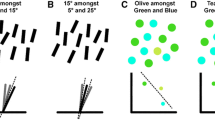Abstract.
This research investigated the effects of an orientation illusion on action, as well as the ability of the motor system to adapt to the illusion. Subjects reached out and picked up a small bar placed at various orientations. A background grating was used to induce an orientation illusion. When the direction of the illusion was reversed, the following seven trials revealed a large illusion effect in the early portion of the reach. In the subsequent seven trials, no effect of the illusion was present. This pattern of adaptation was similar to the pattern often obtained with displacing prisms, suggesting that the two types of visual distortions present the motor system with similar challenges that it meets in similar ways. These findings are consistent with a planning/control model that argues for separate visual representations underlying the planning and on-line control of reaching.
Similar content being viewed by others
Author information
Authors and Affiliations
Additional information
Electronic Publication
Rights and permissions
About this article
Cite this article
Glover, S., Dixon, P. Motor adaptation to an optical illusion. Exp Brain Res 137, 254–258 (2001). https://doi.org/10.1007/s002210000651
Received:
Accepted:
Issue Date:
DOI: https://doi.org/10.1007/s002210000651




